Taft Academic Center
Contact Information
| Taft High School Principal: |
Mark Grishaber |
| Academic Center Director: |
Rhonda Varney |
| rjvarney@cps.edu | |
| Phone: |
773-534-1029 |
| Web site: | www.tafths.org |
| Address: |
6530 West Bryn Mawr |
| Freshman class size: | 155 |
Admissions
Taft is the third most competitive Academic Center in terms of average admissions scores – behind Whitney Young and Lane Tech.
In 2015-2016 (the most recent admissions cycle), the average admissions score at Taft was 766 on the 900 point admissions scale – down 13 points from last year’s 779. For the first time CPS used the more rigorous MAP test as its 5th grade standardized test in its admissions formula. The use of this test put pressure on Tier 1 scores in particular. Average scores for Tier 1 students fell 45 points while scores for Tier 4 students fell only 7 points. The fall in Tier 1 scores is largely responsible for the decline in average admissions scores for Taft’s Academic Center.
In 2012, CPS decided to reclassify its Tiers. One effect of this reclassification was to “upgrade” nearly all north and northwest side areas to Tier 4 – if they were not already in that group. Since Taft is located on the northwest side – it’s geographically remote from most Tier 1 and Tier 2 residents. This has made it more difficult for Taft to attract academically advanced students from lower Tiers.
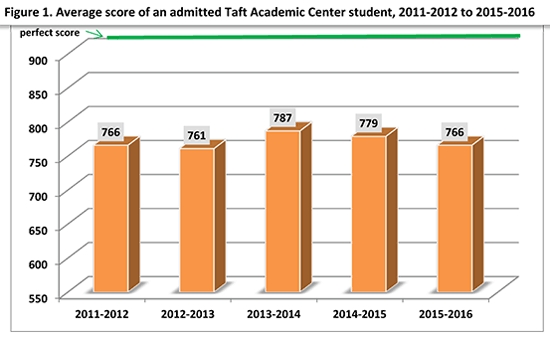
For the past six years, CPS has been using a socioeconomic Tier system to select students for all of its selective admissions schools, including Academic Centers. Currently, thirty percent of seats are allocated to students with the highest academic performance citywide – regardless of their “socioeconomic status”. The remaining seventy percent are allocated to each of four socioeconomic Tiers, with each Tier receiving 17.5%. Students compete for this portion based their academic performance in comparison with other students in their Tier.
Use of the Tier system has led to significant gaps in the academic achievement required for admissions between students from different parts of the City of Chicago. There is a particularly large gap between admissions scores of Tier 4 (the highest socioeconomic Tier) and Tier 1 (the lowest socioeconomic Tier) students – in the more competitive schools.
In each of the past four years there was a gap of over 100 points between the average score of an admitted Taft Academic Center Tier 4 and Tier 1 student. Such a huge gap means that students accepted into the Taft Academic Center have significantly different academic qualifications. Because of its location on the northwest side, an area distant from most Tier 1 students, Taft continues to struggle to attract academically talented Tier 1 students. Taft must reach far into this Tier’s applicant pool to meet its quota of Tier 1 students.
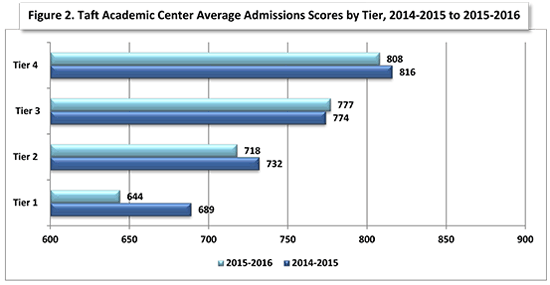
In the most recent admissions cycle the gap between the average score of an admitted Tier 4 and Tier 1 student was 165 points and the gap between the cut-off score for a Tier 4 and Tier 1 student was an astounding 294 points. The existence of gaps of this magnitude among incoming Taft Academic Center students means that students enter Taft with dramatically different academic backgrounds.
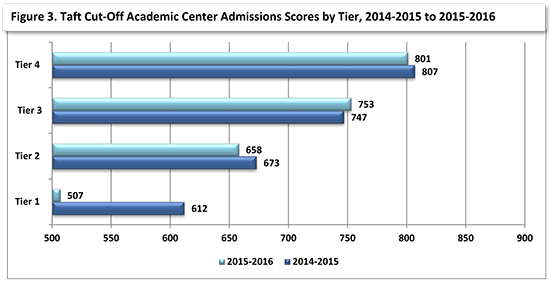
Programs
In 7th grade, students take an accelerated program that includes Pre-Algebra, Honors Environmental Science, Social Sciences Emphasis on Colonial American History, Language Arts-Reading, Fine Arts, Computer Technology, World Language (Spanish or French). In 8th grade, students can take an accelerated program that includes Algebra I Honors, Honors Biology, U.S. History Honors with Public Law Unit, Honors Survey of Literature, Fine Arts, Environmental and Spatial Technology, and World Language (Spanish or French).
Unlike Whitney Young or Lane Tech’s Academic Centers where 7th graders start in Algebra and then move to Geometry in 8th grade, Taft Academic Center starts its 7th graders in Pre-Algebra rather than Algebra and then moves to Algebra in 8th grade.
Each of the above “Honors” classes enables a student to earn high school credit (up to 7 high school credits in total) – and thereby enroll in a more advanced high school program.
Academics
Standardized tests administered to middle school CPS students are in a state of flux. The ACT organization is phasing out the EXPLORE test which has been administered to 8th and 9th graders and is transitioning to the Aspire test. The ISAT is being phased out in favor of the PARCC and MAP test. As this transition takes place it leaves the ISAT with the only up-to-date, multi-year and comparable data for CPS schools, so information from this test is used to assess Academic Center performance.
In 2014, Taft Academic Center 8th graders turned in very strong performance on the Math portion of the ISAT. About 94% of Taft AC 8th graders met or exceeded standards in Math and a healthy 32% exceeded standards.
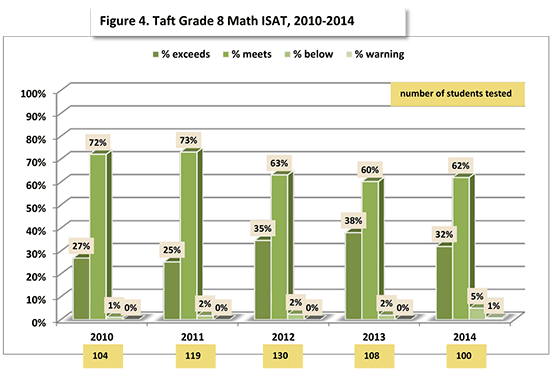
Similarly, in 2014 Taft 8th graders performed very well in the Reading portion of the ISAT — 95% met or exceeded standards for Reading and a very healthy 44% exceeded standards.
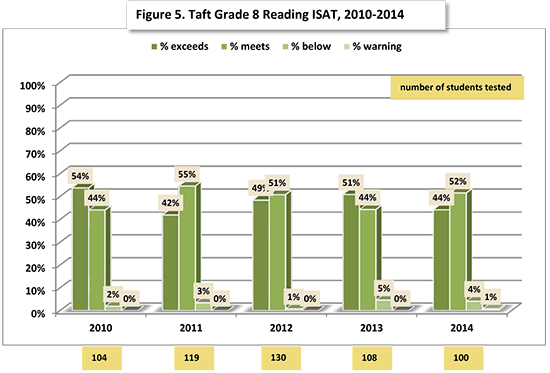
State of Illinois Rankings
State of Illinois Rank: 14 (2013). In 2013, Taft Academic Center was ranked 14th among Illinois’ middle school population of 1,389 schools by the Chicago Sun-Times. This puts Taft’s Academic Center in the top 1% of Illinois’ middle school population.
Taft’s High School was ranked 513th among Illinois’ high school population of 689 schools, putting Taft’s high school in the bottom third.
The Chicago Sun-Times bases its middle school ranking on average ISAT Reading and Math scores and high school rankings using average PSAE scores.
For additional academic information about Taft Academic Center, click here for a state report card.
